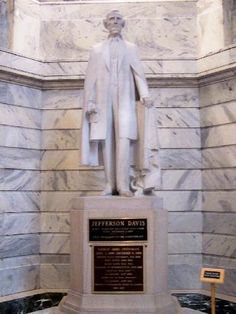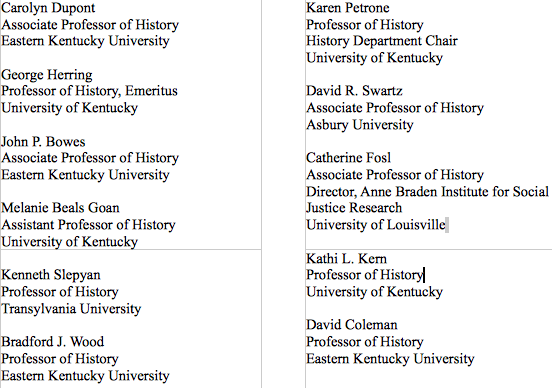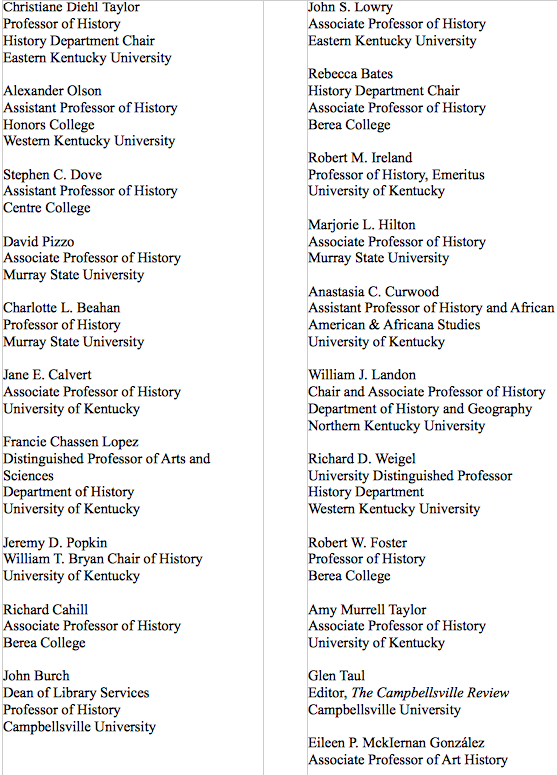Special to NKyTribune

Seventy-two historians from 16 Kentucky colleges and universities have signed a letter recommending removal of the Jefferson Davis statue from the Capitol Rotunda. The missive is addressed to House Speaker Greg Stumbo and members of the legislature, with copies going to the Kentucky Historic Properties Advisory Commission and Gov. Steven Beshear.
According to a press release from the signees, the letter conveyed the historians’ “unambiguous opinion” that “the statue offers a visceral and potent miseducation.” Placing Davis “among the state’s most honorable and noble . . . depicts [him] as a hero with an honorable cause,” claims the letter. Further, state the historians, implicit in honoring Davis is a historical perspective that “minimizes the significance of slavery as a cause of the Civil War, downplays the human suffering of millions, and endows the southern cause with a nobility it does not deserve. At worst, such a depiction winks at the war as a charming national fistfight, rather than a national tragedy of the most profound proportions.”
They added that they were not satisfied with the Historic Properties Advisory Commission’s recent decision to add a plaque with “educational context” about Davis, the Confederacy and their meanings in American history (See NKyTribune story here). They note that adding such material will send mixed messages.
The letter, including its signees, follows:
August 25, 2015
House Speaker Greg Stumbo
Members of the Kentucky Legislature
700 Capitol Avenue
Capitol Room 309
Frankfort, KY 40601
Dear Speaker Stumbo and Members of the Legislature:
We, the 72 professional historians who have signed below, all hold or are retired from teaching and research positions at sixteen post-secondary educational institutions in Kentucky. We offer our unambiguous opinion that the statue of Jefferson Davis in the state’s Capitol Rotunda should be removed to a museum.
The Davis statue conveys a powerful message. Here Davis appears, quite literally, larger than life. He is carved from precious and weighty stone, denoting gravity and permanence. In the Rotunda, he is elevated in public space, on display as a beacon of Kentucky’s highest ideals. Indeed, he towers over onlookers among the state’s most honorable and noble, where the very architecture bespeaks power and reverence. The sanction of our government seems to rest upon him.
Yet rather than honoring the past, the statue offers a visceral and potent miseducation. The statue is not a neutral evocation of facts, but an act of interpretation that depicts Davis as a hero with an honorable cause. Virtually no respected professional historians embrace this view–a perspective that minimizes the significance of slavery as a cause of the Civil War, downplays the human suffering of millions, and endows the southern cause with a nobility it does not deserve. At worst, such a depiction winks at the war as a charming national fistfight, rather than a national tragedy of the most profound proportions.
Public spaces and imagery play a powerful role in teaching history, often reverberating more prominently in students’ minds than the material they learn in school. Unfortunately, Kentucky’s landscape is riddled with images that belie the actual facts of history, the Davis statue among them. It joins the ranks of over 70 other Confederate monuments—and only two Union memorials—in a state that never joined the Confederacy and whose soldiers fought overwhelmingly for the Union. As professional historians, we painstakingly work to convey a past rooted in evidence, but we find our attempts to cultivate public memory undermined by a landscape that reinforces misconceptions. We could press our concern about misleading memorials even further. Where in public space, to offer just one example, do we tell the story of Kentucky slaves, whose labor constituted the economic lifeblood of our country, whose work made possible the men honored in the Capitol, whose initiative secured their own emancipation, and whose bravery contributed importantly to the Union victory? Doesn’t the Historic Properties Commission have an obligation to tell a story that better honors the lives of all Kentuckians? Our citizens will continue to carry the heavy burden of mistaken assumptions if we do not offer a less distorted narrative in our public memorials.
Neither do we find any satisfaction in the proposed addition of a plaque that will add “educational context” about Davis, the Confederacy, and their meanings in American history. A bit of text that is easily overlooked or ignored, lacking in graphic impact, and accessible only with effort cannot undo the more powerful falsehoods conveyed by the statue. In fact, the addition of such explanation will make this statue the most schizophrenic of presentations. On the one hand, the statute celebrates Davis as an eminently honorable man, while on the other a plaque would inevitably inform visitors that he defended a brutal system of human bondage, committed treason against the United States, and helped start the bloodiest war in our history.
Perhaps more than most people, we believe that history must stay alive; indeed we have all dedicated our lives to uncovering, preserving, and teaching the past. However, removing the Davis statue would not “erase history;” it would rather make room to elevate in his place a more deserving Kentuckian. Many of us stand ready to help select a worthy alternative.
Cc: The Kentucky Historic Properties Advisory Commission
Governor Steven Beshear
Most sincerely,

























